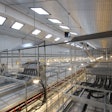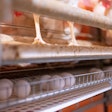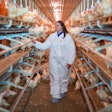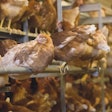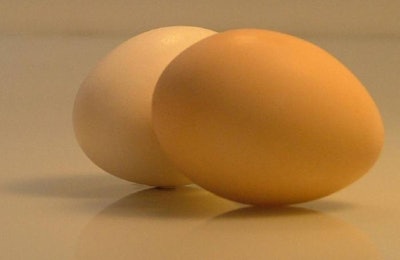
Like it or not, cage-free is becoming the defining trend in the U.S. egg industry, and the country’s producers will need to adapt operations and housing to supply their customers.
In early May 2016, the U.S. Department of Agriculture’s (USDA) Agricultural Marketing Service estimated 176.5 million cage-free layers would be required by 2025 to supply all of the cage-free purchase pledges made by U.S. retailers, foodservice outlets, distributors and food manufacturers. Currently, the USDA estimates the country’s cage-free non-organic layer flock at around 18.0 million hens and growing rapidly.
To accommodate these purchase pledges, egg producers must decide quickly which type of cage-free housing system they should use to supplement, or replace, their cages.
Egg Industry is publishing a series of articles discussing the advantages and disadvantages of three types of cage-free housing systems: aviaries, floor systems and combination, or combi, systems. This article focuses on aviaries.
Egg Industry surveyed cage-free housing manufacturers from around the world to gather their input on their systems. Big Dutchman Inc., Farm Innovation Team GmbH (FIT), Jansen Poultry Equipment, Valco Companies Inc./Valli Spa, Potter’s Poultry International, Tecno Poultry Systems LLC, Vencomatic Group, and Hellmann Poultry GmbH & Co. KG responded to the survey.
1. What aviaries look like
While there is significant variance depending on the manufacturer, aviaries provide a multi-tiered environment for hens which allows for higher housing density per cubic foot than floor and nest systems, but less density than cages and some combi-systems. Generally, aviaries feature egg and manure belts underneath the housing tiers as well as feed and water systems to manage the bird’s biological needs. Unlike cage housing, there is no permanent “front” to the system confining birds to the system full-time.

Aviaries allow for higher stocking densities per square foot of floor space than do floor systems. | Courtesy Hellman Poultry
Aviaries are outfitted with perches, scratch pads and nesting areas designed so hens can express all of their natural behaviors. Many have ramps for birds to move between the tiers of the system. Some are outfitted with closing doors for temporary confinement of the animals, but the feature is controversial among groups that certify an operation is humane.
2. Advantages and disadvantages of aviaries
Survey respondents agreed aviaries, with or without a door, are the most popular housing option in the EU, where conventional cages were banned in 2012.
Potter’s, based in Rugby, U.K., said aviaries, especially when compared with cages, are more “visually appealing” because they appear to give the birds more free-ranging capabilities within the barn. Farmers have told Potter’s birds prefer aviaries over conventional housing.
“They are convinced that the activities of the birds, and natural instincts of the hens being able to roost up higher makes their birds in this system much ‘happier’ than when they had their flocks in nests and slat houses,” it said in its response.
Aviaries are also highly customizable, which can help meet the standards of certain certification agencies and regulators. Vencomatic, of Eersel, Netherlands, said feed, water, lighting, perching and nest close-out features can help achieve those requirements or improve the bird’s comfort. Steinfurt, Germany-based FIT said greater access to nests afforded by the tiered system can reduce competition between birds for nesting space and lead to less stress associated with a pecking order in front of the nests.
Manufacturers said birds perform best in aviaries when they’ve lived in similar housing their entire lives. Pullets must be raised in systems that are compatible with the aviary in the layer house so they are trained to move up into the system and throughout its tiers before they reach the house. Birds who were not raised in an appropriate pullet system will have a harder time adjusting, will be more likely to lay floor eggs, and generally will not perform as well as birds raised in a rearing aviary.

Aviary-housed layers perform better if they were raised as pullets in systems similar to what they will inhabit in the layer house. | Courtesy Jansen Poultry
Val-Co, based in New Holland, Pennsylvania, said cage-free systems, which expose birds and their eggs to feces, carry food safety risks and could lead to future food safety challenges.
3. Advantage and disadvantage of doors
Some manufacturers said aviaries with closing doors bring significant management advantages to the farm. Other manufacturers argued those advantages are outweighed by the fact that activists, welfare certifying bodies, regulators and consumers may soon reject any system with temporary confinement.
Big Dutchman said the closing door feature attached to some of its aviaries gives farmers more freedom to inspect and clean their barns, reduces overall labor requirements for cage-free housing, and a significantly reduces floor eggs.
Confining birds from the evening to the morning, the Holland, Michigan, company said, gives workers more freedom to move through the house and inspect the system than if the house were full of hens. Because the birds can be kept inside the system until after the morning lay, the door prevents floor eggs and facilitates the capture of droppings by the manure belt.
“About 90 percent of the manure is collected inside the system on the manure belts from early morning until just after the egg-laying period, and prior to the doors opening automatically for the day,” it said in its survey. “It takes fewer man hours to manage this type of system because you are dealing with a smaller amount of manure that builds up in the aisleways and you spend less time searching and picking up mislaid eggs.”

A means of enclosing birds inside the aviary system can ease a flock’s transition from the pullet house to the layer house. | Courtesy Potters Poultry

With the hens steeled into this aviary, the doors are removed and hens can move into and out of the system and down onto the floor. | Courtesy Potters Poultry
FIT said the enclosure system can ease a new flock’s transition into their environment before they begin to lay. Closing doors facilitate the administration of any medication or vaccination program, too.
Jansen, which does not manufacture closing aviaries, offered a counterpoint: The Barneveld, Netherlands, company said consumers will soon become aware of what it called a half-a-cage system being called a cage-free system. Marketers could latch onto the issue and pressure consumers not to buy eggs from producers that use closing aviaries.
“The consumer will decide which production system will be used, not the poultry industry, egg producers and cage manufacturers,” Jansen said in its response.
Vencomatic, which also does not manufacture closing aviaries, argued aviaries with doors are already at risk of being regulated out of existence in Europe, and certifiers are quickly closing the door on allowing birds more than a few weeks old to be confined. They say that purchasing a system that cannot be certified cage-free in the future would not be a wise investment.
4. Labor considerations
Respondents said cage-free operations can require anywhere from two to four times more labor than cage systems.
Vechta, Germany, manufacturer Hellmann said labor requirements for aviaries are similar to cages, but generally more labor is needed for inspections and bird management. Vencomatic said the barn and housing system’s layout, the farm’s management practices and even the lighting inside the barn can play a role in labor needs.

Allowing enough space in the aisleways for bird activity and worker movement through the system is an important consideration when placing aviaries in a house. | Courtesy Tecno Poultry
Val-Co said hens’ training before moving into the layer house can factor into labor needs.
“Will the birds be trained to learn vertical movement, either in the pullet or hen houses, so they readily go from the cage or slats to the floor? Will there be floor eggs to gather or is the system designed for all eggs to roll on to belts? The increase in labor is normally proportional to the level of bird training desired,” Val-Co said in its response.
Potter’s said there is always significant labor involved in placing pullets into the barn, and more attention – such as routinely walking the house and monitoring the health of the birds – required during the flock’s first two to three weeks in the system. It estimates about 0.2 hours of labor are needed per day for every 1,000 birds housed in its systems.
Many aviaries are designed with raised walkways or specialized corridors for barn workers to move through the house for routine inspection of the birds and the system’s components with minimum disruption to the flock. Those features are added to reduce overall labor needs. Manufacturers of aviaries with closing doors said keeping the birds in the system at certain times – such as in the evening or early morning – can reduce the house’s overall labor requirements as well.
Jansen pointed out that farmers transitioning from cages to cage free will have trouble at first, and it will take more time than usual to manage the flock, but this issue will be alleviated with time and experience.
5. Other cage-free tips
Survey respondents offered general advice for farmers considering making the switch to cage-free. They said the decision on which type of cage-free system will be installed should not be made lightly and there should be serious research invested in the system and its supplier and how it will interact with the profitability of the operation.
Val-Co and Vencomatic suggested farmers consider long-term market projections and consumer demand. While there are drawbacks in feed conversion, in Europe farmers are already seeing their labor and capital expenses coming in line with conventional housing.
“Yesterday, we thought that these changes would be 10 years out; today we know that they are actually coming much more quickly. We know from experience that the animal welfare organizations will not be content with the industry as it stands,” Vencomatic said in its response. “Cutting corners will result in producers being forced to reinvest in the future or limit themselves to less lucrative contracts.”
Jansen made a similar argument.
“Consumers demand cage-free eggs so any additional cost is not the determining factor if you want keep on selling to the consumers who will be even more influenced by advertising from many retailers promoting their new product: cage-free, organic (or) free-range eggs. So extra cost questions are obsolete in this situation,” Jansen said. “By increasing the production of first-class eggs that can be labeled as cage-free, farmers will be paid more for their eggs.”
Read about the aviary door controversy at:













